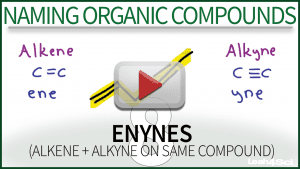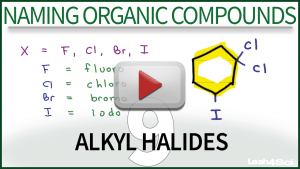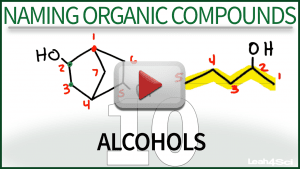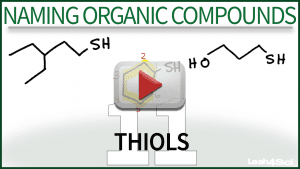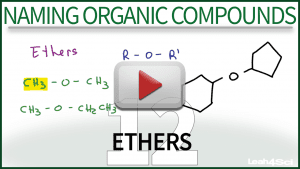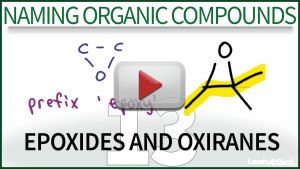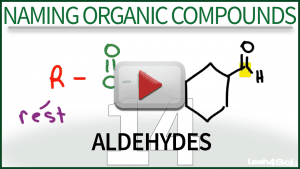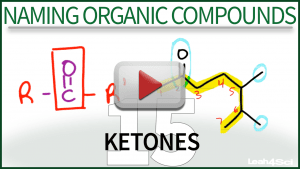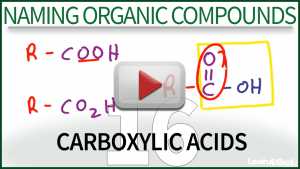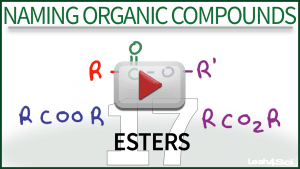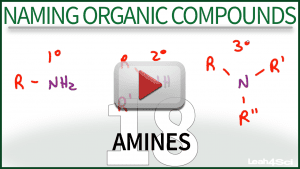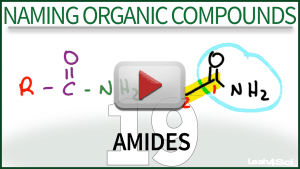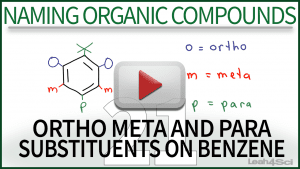
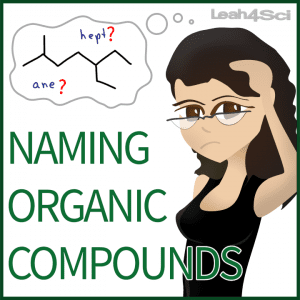 Nomenclature, or the naming of organic compounds, is a key requirement in any organic chemistry course. You will start out with the basics, being tested on naming molecules and drawing molecules from a given name.
Nomenclature, or the naming of organic compounds, is a key requirement in any organic chemistry course. You will start out with the basics, being tested on naming molecules and drawing molecules from a given name.
But it doesn't stop there. As you proceed with your organic chemistry course you will be tested on reactions and mechanisms, but may find yourself faced with the name of a molecule instead of its drawing. No matter how many times you practiced a mechanism, if you don't know your starting molecule, you won't be able to answer related questions.
Despite the importance of nomenclature, this topic is often rushed in the orgo curriculum and textbook. That's why I created this 21-video series to take you through naming step by step using my Puzzle Piece Approach. This will help you find patterns and see the logic with every additional concept and rule.
YouTube likes and shares are greatly appreciated for every video 🙂
Make sure to download my free Functional Groups Cheat Sheet, and for even more practice, test your knowledge with my Naming Organic Compounds Practice Quiz.
Included in this series:
Click on the specific videos listed as follows or on the icons below:
- Pre-Naming Video – Organic Chemistry Functional Groups
- Introduction To IUPAC Nomenclature
- Naming:
- Alkanes – Straight Chain, Branched Chain, Branched Substitutents (isopropyl, isobutyl, tertbutyl +), Cylcoalkanes & BicycloAlkanes
- Alkenes, Alkynes, Enynes (alkene + alkyne on same compound), Alkyl Halides
- Alcohols, Thiols, Ethers, Epoxides & Oxiranes, Aldehydes, Ketones, Carboxylic Acids, Esters
- Amines, Amides
- Aromatic Compounds (+ Benzene v Phenyl), Ortho/Meta/Para Substituents on Benzene
 Pre-Naming Video – Functional Groups
Pre-Naming Video – Functional Groups
You must first recognize functional groups in order to name molecules. These groups influence reactivity as you progress in the course. This video will take you through all the common groups with tips & mnemonics to help you recognize and differentiate between the tricky ones. Try my Functional Groups Practice Quiz!
Video 1 – Introduction To IUPAC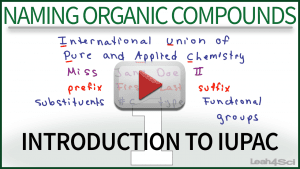
The rules for naming organic compounds are tedious and can become overwhelming fast. The first video shows you how to break down the name of an organic molecule using my ‘puzzle piece approach'. This video is a MUST for breaking down nomenclature in a simple and fun-to-solve manner.
Video 2 – Naming Straight Chain Alkanes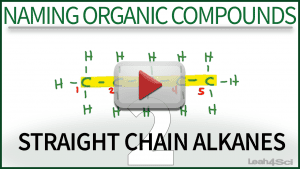
This video teaches you how to name/recognize a simple or straight-chain alkane. Including examples of straight chain alkanes presented in condensed molecular formula, structural formula, and line or skeletal structure.
Video 3 – Naming Branched Chain Alkanes
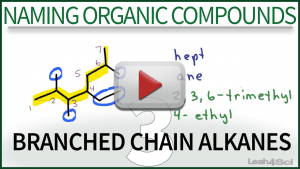 The complexity starts when we add a ‘branch' or carbon substituent. This videos teaches you how to tackle molecules with one or more alkyl substituents/branches. Examples include single substituent to multiple same and varied branches
The complexity starts when we add a ‘branch' or carbon substituent. This videos teaches you how to tackle molecules with one or more alkyl substituents/branches. Examples include single substituent to multiple same and varied branches
Video 4 – Naming Branched Substituents – isopropyl, isobutyl, tertbutyl, and more
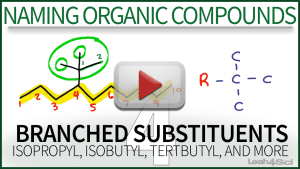 You may find a molecule containing a branched branch, or a substituent containing its own substituents. These can get tricky to name, but there are accepted ‘shortcuts,' explained in this video! Examples include ispropyl, isobutyl, secbutyl, and tert butyl substituents.
You may find a molecule containing a branched branch, or a substituent containing its own substituents. These can get tricky to name, but there are accepted ‘shortcuts,' explained in this video! Examples include ispropyl, isobutyl, secbutyl, and tert butyl substituents.
Video 5 – Naming Cycloalkanes & Bicyclo Alkanes
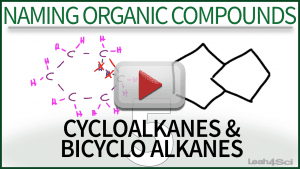 Cycloalkanes have the first and last carbon of the chain fused. One cycloalkane follows the same naming pattern with a few differences. However, more than one fused ring has a drastically different naming pattern. Examples include single, fused, & substituted cyclic compounds.
Cycloalkanes have the first and last carbon of the chain fused. One cycloalkane follows the same naming pattern with a few differences. However, more than one fused ring has a drastically different naming pattern. Examples include single, fused, & substituted cyclic compounds.
Video 6 – Naming Alkenes
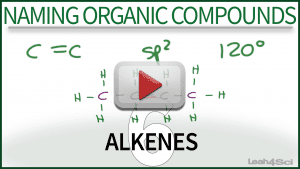 A single pi bond introduced into the organic compound calls for a slight change in the naming pattern. This video shows you how to name with one or more double bonds while still following my ‘puzzle piece' approach.
A single pi bond introduced into the organic compound calls for a slight change in the naming pattern. This video shows you how to name with one or more double bonds while still following my ‘puzzle piece' approach.
Learn more about Cis Trans and E Z Geometric Isomers here!
Video 7 – Naming Alkynes
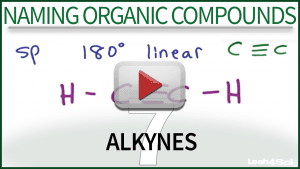 When your compound contains two pi bonds between the same set of carbon atoms, you have an alkyne. Naming an alkyne is similar to alkenes, with a slight change in the ‘last name' of the molecule.
When your compound contains two pi bonds between the same set of carbon atoms, you have an alkyne. Naming an alkyne is similar to alkenes, with a slight change in the ‘last name' of the molecule.
Video 8 – Naming Enynes (alkene + alkyne on same compound)
If a molecule contains alkenes or alkynes, you know what to do from Videos 6 & 7. But what do you do when the molecule contains BOTH! This is explained with a few examples in the ene + yne = enyne video.
*Organic Chemistry Functional Groups*
Videos 1-8 focus on the naming basics, videos 9-21 focus on naming functional groups that show up within organic compounds. If you're not fully confident with the name or structure of the different functional groups – grab my FREE Organic Chemistry Functional Groups Cheat Sheet
Video 9 – Naming Alkyl Halides
Video 10 – Naming Alcohols
Video 11 – Naming Thiols
Video 12 – Naming Ethers
Video 13 – Naming Epoxides and Oxiranes
Video 14 – Naming Aldehydes
Video 15 – Naming Ketones
Video 16 – Naming Carboxylic Acids
Video 17 – Naming Esters
Video 18 – Naming Amines
Video 19 – Naming Amides
Video 20 – Naming Aromatic Compounds (+ Benzene vs Phenyl)
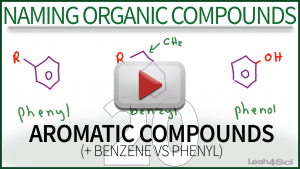
Video 21 – Naming Ortho Meta and Para Substituents on Benzene
Looking for how to name Cis/Trans or E/Z compounds? Read HERE!
Or, need even more naming practice? Watch the video below, and then continue on by trying my Naming Organic Compounds Practice Quiz (with PDF solutions).
